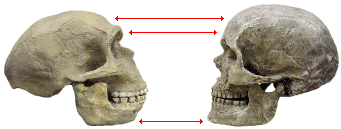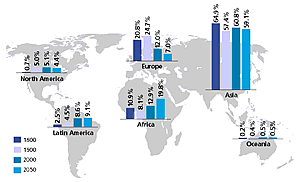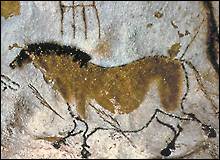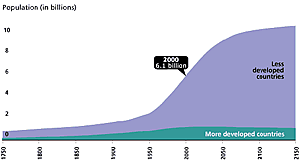Scientific Name: Homo sapiens. Subspecies: Homo sapiens sapiens.
 |
| Modern human (right) and Neanderthal skulls. Photo: produced by Dennis O'Neil |
Phylum or Division: Chordata.
Subphylum: Vertebrata.
Class: Mammalia.
Order: Primates.
Family: Hominidae.
Subfamily: Pongidae.
Identification: Ape with bipedal posture. Skin may be various shades of beige, dark brown, or light brown. Has little hair, primarily on top and back of head, which may be blonde, brown, black, or red. Eyes may be brown, blue, green, hazel, or grey. Has opposable thumbs, and nails on the fingers and toes, but lacks a tail. Makes tools and technology. Builds shelters of all shapes and sizes. Some populations are nomadic. The H. sapiens sapiens skull is smaller and more compact and the face is much less elongated compared to the Neanderthal (Homo neanderthalis); the modern human skull has a higher forehead, less prominent brow-ridges and smaller teeth. Modern humans are typically much less robust in body form and skeleton than Neanderthals.
 |
| Human Population Distribution, 1800-2050 Photo: United Nations Population Division |
Current Distribution: Worldwide. Extremely adaptable and intelligent, it has acclimated to nearly every ecosystem through evolutionary and technological means. Has become established on all 7 continents and is beginning to colonize the planet's orbital regions. Primarily found on land; may also be found for short periods on water surfaces and in the air in transports. On land, prefers coastal locations or regions near water sources.
Site and Date of Introduction: (to North America:) First wave, a group from Siberia in Asia at repeated intervals between 40,000 and 13,000 years ago across the Bering Land Bridge to Alaska. Second wave, a group from Scandinavia in 1000 A.D. across the North Atlantic Ocean to Northeastern North America. Third wave, from Europe to the Caribbean in 1492 A.D. which led to mass immigrations thereafter.
Mode(s) of Introduction: (into all new areas of the world:) By foot via natural land passages. Later by boat/ship sometime during prehistory; first record is 7th century B.C. By air beginning in 1904 A.D. By spacecraft beginning in 1961 A.D.
 |
| Norman Rockwell's Golden Rule depicting humans of every race and culture Photo: United Nations |
Ecological Role: Primarily a predator species. Through intelligence and technology, has successfully eliminated threat by all natural predators (large carnivores), other than disease. Impacts all stages of the ecosystem in countless ways via agriculture, water use and redirection, airborne pollutants, etc. The species has become adept at science and technology, to the point of decoding its own genome and experimenting with genetic manipulation of its own and other species. Medical developments, including reproductive technologies, have increased the lifespan and quality of life for individuals of its own and other species. Actions are causing the extinction of other species on the planet at the rate of 30,000 per year.
 |
| Cave painting, Lascaux, France
Photo: AMNH |
Threat(s): Humans are an extremely well-adapted, successful species and in becoming dominant they have crowded out and assumed resources from many other species, particularly large mammals which require large amounts of resources and a large range to survive. Humans are greedy by nature, liking a large home range and a wide variety of food resources. They are also unnecessarily wasteful. Overpredation is a large problem and has led to the extinction of many other species. Those that remain do so in terribly low numbers that can be counted. In addition to taking existing resources, human technology and population size contribute large quantities of pollutants which lead to toxicity of remaining resources including air, water, land, soil, and prey.
The consequences of this species cerebral growth and resulting intelligence have been enormous. Cultural evolution has resulted in Homo sapiens sapiens becoming a species that could change the environment to meet its needs and not have to adapt to an environment through natural selection. Effects have been devastating. As a direct result of human changes to the environment, the extinction rate of other living organisms is 50 times greater than normal. Such changes include habitat destruction and chemical pollution, destruction of tropical rain forests, and disruption of the atmospheric gas balance, spread of disease, and introduction of foreign species into new environments. This extremely territorial and emotional species is prone to anger and violence, often resulting in the outbreak of warfare on an ever-larger scale. Human intelligence and collective knowledge in the areas of chemistry and physics have led to the development of atomic and nuclear bombs, which if used threaten the existence of life on the entire planet. Biological knowledge has led to the capacity for genetic manipulation, and carelessness or error could lead to biological devastation via the development of "superbugs" or genetically modified species becoming invasive. Additionally, this species has become so numerous and so dominant that it has even reached the capacity to affect the world climate via global temperature change, destroying the ozone layer, and affecting global weather patterns. The recent population explosion of Homo sapiens sapiens is possibly the most devastating crisis in the history of life.

World Population Growth, 1750-2150
Photo: United Nations/Population Reference Bureau
Control Level Diagnosis: Highest Priority.
Control Method: It is believed that the sheer numbers of this species will bring the planet to its carrying capacity and reach critical mass very soon, if it hasn't already. As with all dense populations, disease epidemics are expected to increase in frequency and intensity, and a worldwide plague or resource crisis will cause widespread casualties. Self-imposed population control measures may become necessary. Yet this species will likely never be entirely eliminated except by its own self-destruction. It is hoped the species will develop the intelligence level to control the consequences of its own actions. (If all else fails, everyone could just join the Voluntary Human Extinction Movement.)
References: